Did you know that hydrotherapy can work wonders for your dog’s health and well-being? In this blog post, we’ll explore canine hydrotherapy and how you can unlock its benefits through hydrotherapy for dogs at home. From easing joint pain to speeding up recovery after surgery, hydrotherapy offers a world of advantages for your beloved pet. So let’s dive in and discover how this natural wellness practice can make a splash in your dog’s life!
Short Summary
- Hydrotherapy is a form of physical therapy for dogs that uses the healing properties of water to help treat conditions and alleviate pain.
- Create a safe, comfortable environment at home and consult with your vet before beginning any hydrotherapy program.
- Seek professional help if you notice limited progress or regression in your pup’s treatment, or have equipment/facility limitations.
Understanding Canine Hydrotherapy
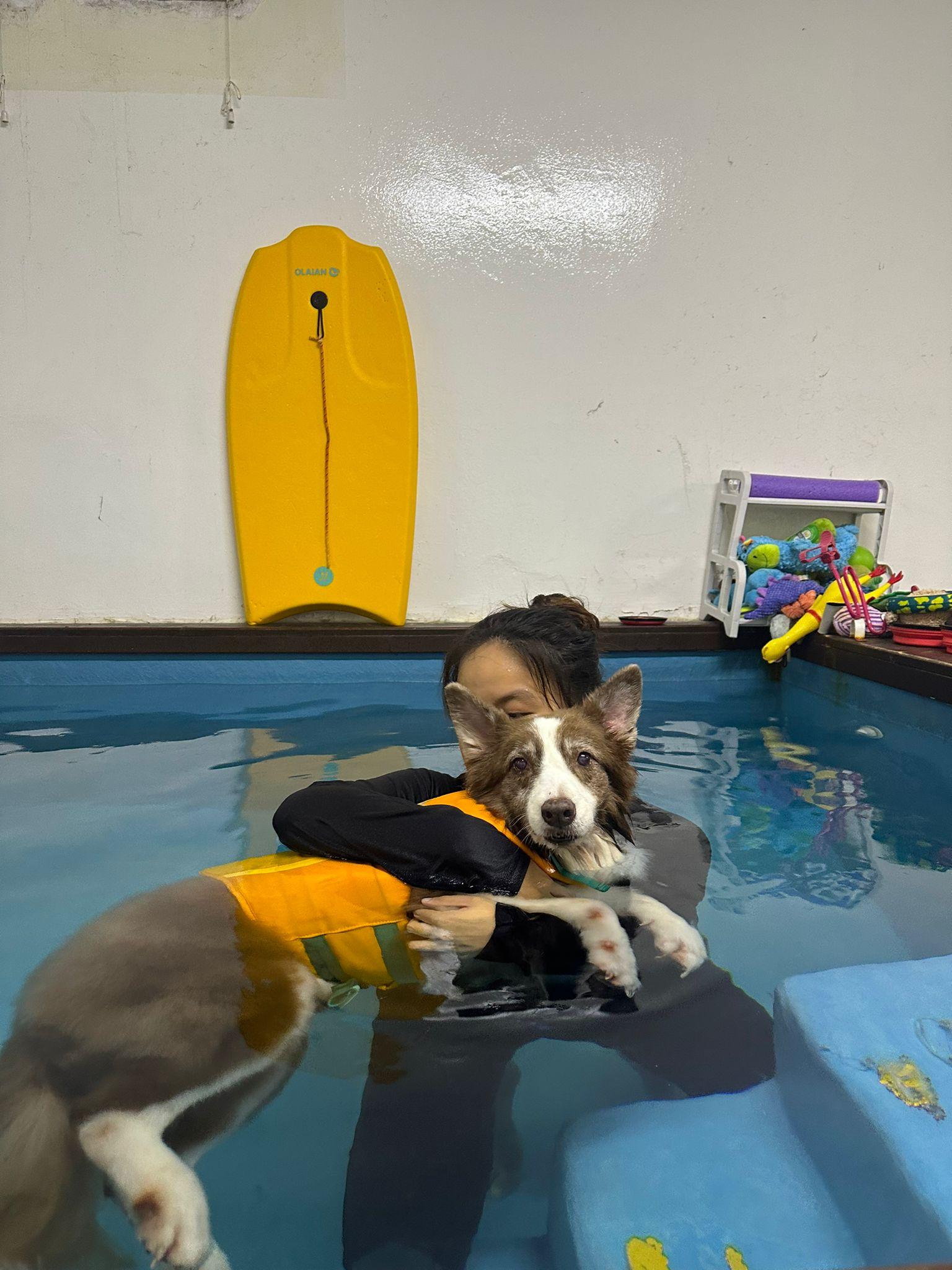 Canine hydrotherapy
Canine hydrotherapy, also known as water therapy or aquatic therapy, is a form of physical therapy that harnesses the properties of water to help treat musculoskeletal and neurological conditions in dogs. From reducing arthritis discomfort to enhancing function after an injury or surgery, hydrotherapy offers a wide range of benefits for our furry friends.
There are three main types of hydrotherapy for dogs:
underwater treadmill, whirlpool therapy, and hydrotherapy pools, each designed to provide the best possible care for your pup. The growing trend of hydrotherapy for pets stems from the healing properties of water, which can help alleviate pain, improve mobility, and offer a gentle yet effective form of exercise.
However, it’s crucial to ensure that hydrotherapy sessions are conducted by a certified hydrotherapist or under the guidance of your veterinarian, who can prescribe the appropriate exercises for your dog’s specific needs.
The Science Behind Hydrotherapy
The success of canine hydrotherapy lies in water’s unique physical properties, including temperature, pressure, buoyancy, resistance, and surface tension. These properties work together to create an ideal environment for rehabilitation, exercise, and recovery. Hydrostatic pressure, for example, is the direct compressive force that water applies on an object submerged in it, which can help reduce the pressure and discomfort on a dog’s joints, bones, and muscles.
Water can offer resistance that can help to increase muscle strength. It also helps in managing pain due to its viscosity and buoyancy properties. Hydrotherapy water is typically maintained at a temperature between 83-90°F, providing a warm and soothing environment for your dog during therapy sessions. With these properties combined, hydrotherapy becomes a powerful tool for addressing various health conditions and enhancing your dog’s overall well-being.
Common Conditions Treated with Hydrotherapy
Hydrotherapy is a versatile therapeutic approach, capable of treating a variety of conditions such as arthritis, hip dysplasia, patellar luxation, obesity, and postoperative recovery. For instance, swim therapy can help dogs with arthritis build muscle mass and relieve pressure on their joints.
Additionally, hydrotherapy can be an excellent weight loss solution, helping prevent the development of arthritis or other chronic health conditions. Orthopedic injuries, neurological conditions, and chronic pain are all complex medical conditions that can benefit from hydrotherapy.
The water’s buoyancy supports the dog, allowing them to move more freely and providing resistance that aids in muscle strength, joint surgery recovery, and reducing the effects of degenerative joint disease.
Home Hydrotherapy Options for Dogs
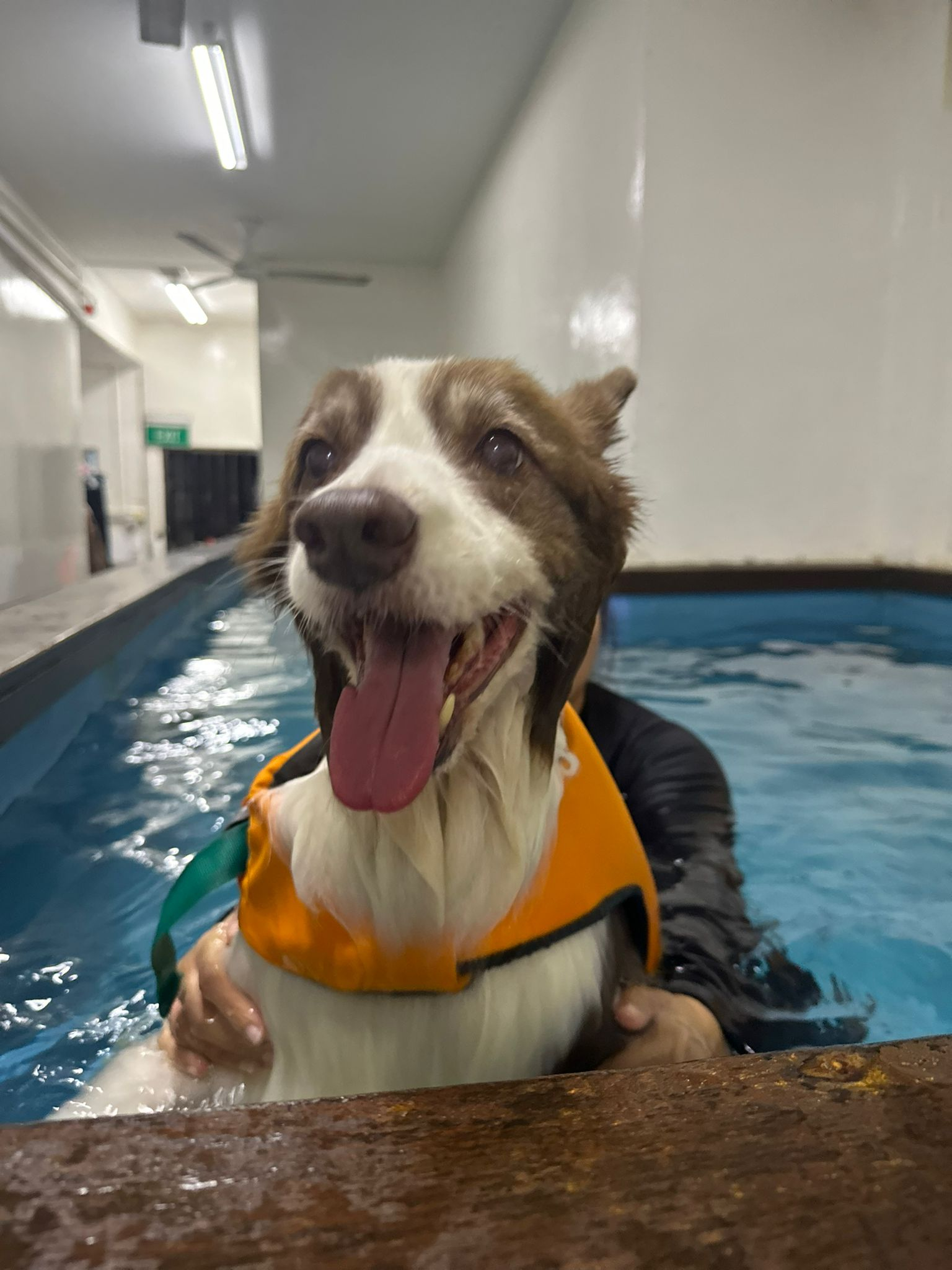
While professional hydrotherapy facilities offer specialized equipment and expertise, there are several at-home hydrotherapy options for dogs that can also provide significant benefits. These options include swimming pools, natural bodies of water, DIY underwater treadmills, and home whirlpool therapy.
Each of these methods can be tailored to your dog’s specific needs and health conditions, ensuring a comfortable and beneficial experience for your furry friend.
Swimming Pools and Natural Bodies of Water
Swimming pools and natural bodies of water are excellent hydrotherapy options for dogs, offering a gentle way to exercise that can help build muscle, improve heart health, and ease joint pain. For dogs with arthritis, swim therapy can be particularly beneficial, as it helps build muscle mass and takes some of the pressure off their joints.
However, it’s essential to consider safety precautions when using swimming pools and natural bodies of water for hydrotherapy. Consult with a veterinarian before starting, ensure that you provide supervision and assistance during the session, and use the right equipment and flotation devices to keep your dog safe in the water.
DIY Underwater Treadmill
A DIY underwater treadmill is an innovative home hydrotherapy option that involves enclosing a treadmill in a tub that gradually fills with water. As your dog walks or runs on the treadmill, they become partially submerged in water, providing the benefits of hydrotherapy while allowing you to control the workout intensity more precisely than swimming.
Setting up a DIY underwater treadmill at home requires some investment in equipment and space, but the benefits for your dog can be well worth it. Before attempting this at-home hydrotherapy method, consult with your veterinarian to ensure that it’s appropriate for your dog’s specific health conditions and needs.
Home Whirlpool Therapy
Home whirlpool therapy is another form of hydrotherapy that can be done at home using a whirlpool or hot tub. This type of hydrotherapy is particularly helpful for dogs dealing with chronic or temporary pain from an injury or those recovering from surgery. Whirlpool therapy can help reduce pain and inflammation, improve mobility, and increase range of motion while promoting muscle relaxation, circulation, and stress relief.
As with other home hydrotherapy options, it’s important to consult with your veterinarian before beginning whirlpool therapy and to ensure that you provide supervision and assistance throughout the session. Additionally, make sure you have the right equipment and flotation devices to keep your dog safe and comfortable during their whirlpool therapy.
Safety and Precautions for At-Home Hydrotherapy
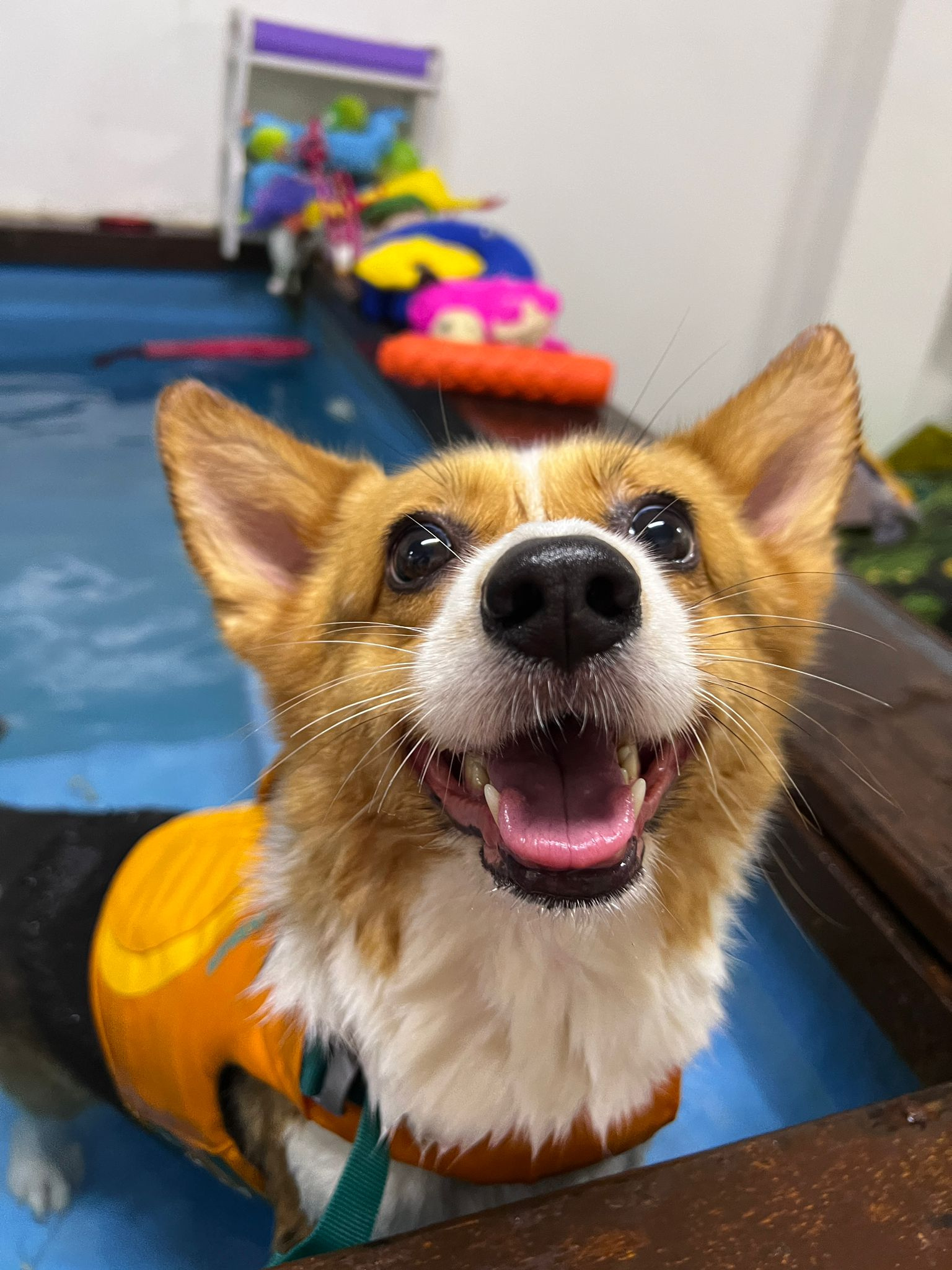
To ensure the safety and effectiveness of at-home hydrotherapy for your dog, several precautions should be taken. These include consulting with a veterinarian, providing supervision and assistance during hydrotherapy sessions, and using proper equipment and flotation devices.
By following these guidelines, you can help create a positive and beneficial hydrotherapy experience for your dog while minimizing potential risks and complications.
Consulting with a Veterinarian
Before beginning any hydrotherapy program for your dog, it’s crucial to consult with your veterinarian. Your vet can help determine if hydrotherapy is the right fit for your dog, suggest appropriate exercises and duration, and ensure that there are no issues such as open wounds or infections that could be problematic during therapy sessions. By consulting with your vet, you can make informed decisions about your dog’s hydrotherapy treatment and ensure their safety and well-being throughout the process.
In some cases, your veterinarian may recommend seeking professional help for hydrotherapy, especially if your dog has a complex medical condition, limited progress or regression, or if there are equipment and facility limitations that prevent effective at-home hydrotherapy.
Supervision and Assistance
During hydrotherapy sessions, it’s essential to provide supervision and assistance to ensure your dog’s safety and comfort. Water can be dangerous for dogs, especially if they’re not natural swimmers, and having a watchful eye on them during the session can help prevent accidents or injuries. Additionally, providing assistance during hydrotherapy can help your dog feel more secure and supported, allowing them to get the most out of their therapy sessions.
It’s also important to monitor your dog’s behavior and reactions during hydrotherapy, noting any changes in their energy level or signs of fatigue, pain, or discomfort. By closely observing your dog and adjusting the length and intensity of the session as needed, you can help ensure that they are receiving the full benefits of hydrotherapy without overexerting themselves or exacerbating any existing health issues.
Proper Equipment and Flotation Devices
Using proper equipment and flotation devices is crucial for your dog’s safety and comfort during hydrotherapy sessions. Life jackets, pool noodles, and pool floats are all excellent choices for ensuring that your dog stays afloat and secure in the water. Ensuring that the equipment and flotation devices are the correct size and fit for your dog is vital to their safety and well-being during hydrotherapy sessions.
When using hydrotherapy equipment and facilities, it’s also essential to ensure that everything is in good condition and that the environment is safe for your dog. Regular maintenance and inspection of equipment can help prevent accidents or injuries, allowing your dog to enjoy the full benefits of hydrotherapy without any unnecessary risks.
Tips for Maximizing Hydrotherapy Benefits at Home
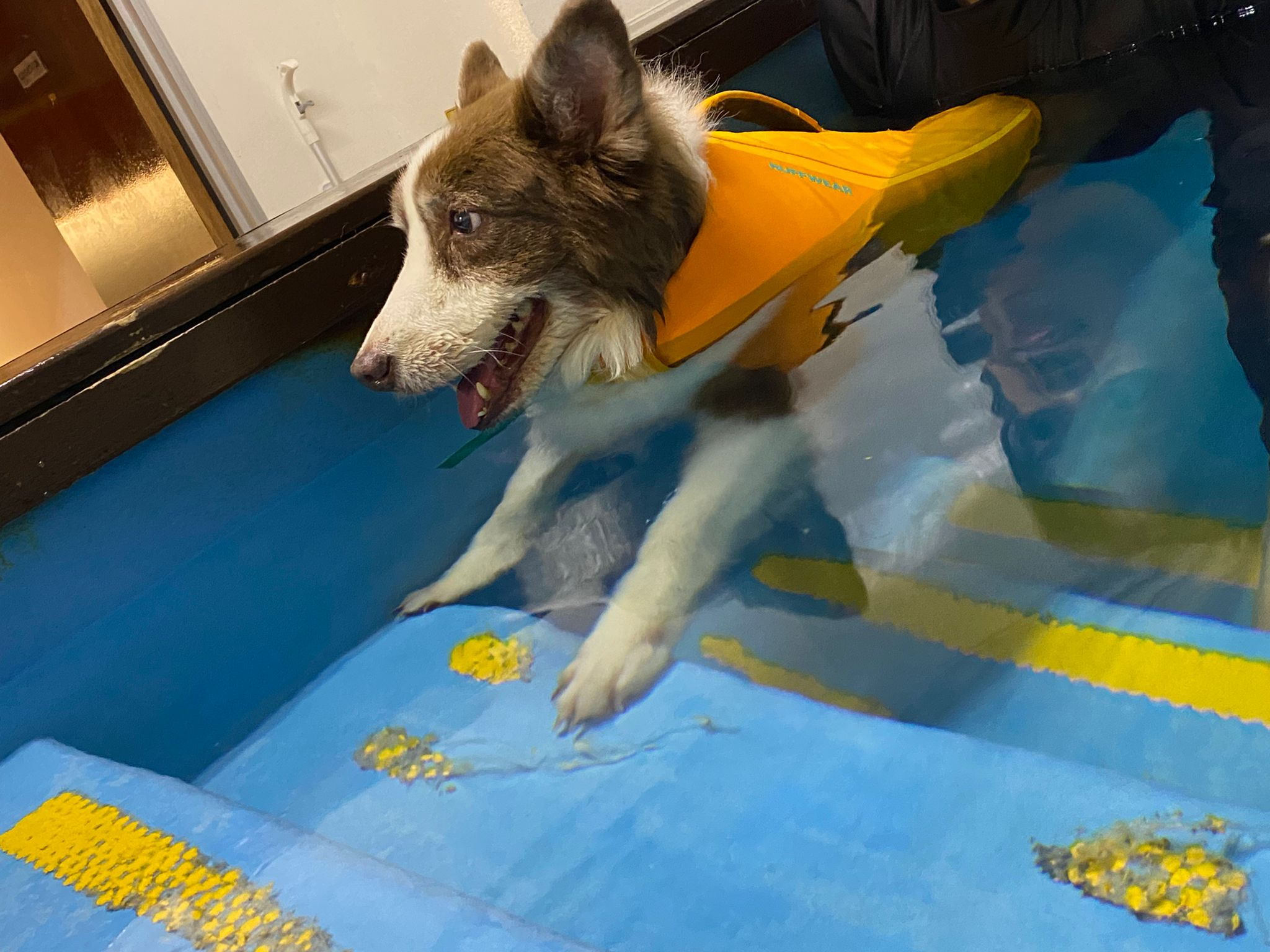
To get the most out of at-home hydrotherapy for your dog, consider the following tips: create a comfortable environment, establish a routine, monitor progress and adjust sessions as needed.
By implementing these strategies, you can enhance the effectiveness of hydrotherapy and support your dog’s overall health and well-being.
Creating a Comfortable Environment
Ensuring that your dog is comfortable during hydrotherapy sessions is essential for the therapy’s success and your dog’s overall well-being. To create a cozy atmosphere, make sure the water temperature is just right, provide a safe and secure area for your dog to move around, and give them some toys and treats to keep them engaged.
By creating a comfortable environment for hydrotherapy, you can help your dog relax, de-stress, and move more smoothly and comfortably, leading to improved blood flow, muscle strength, and overall health.
Establishing a Routine
Establishing a routine for hydrotherapy is key to helping your dog get comfortable with the therapy and make it more effective. Regular hydrotherapy sessions can help your dog build strength, range of motion, and endurance, contributing to achieving their health goals more quickly.
To set up a hydrotherapy routine, consult with your veterinarian to determine the appropriate frequency and duration of sessions for your dog. Once you’ve established a suitable schedule, stick to it and ensure that your dog is relaxed and at ease during each session.
Monitoring Progress and Adjusting Sessions
Monitoring progress and adjusting hydrotherapy sessions as needed is crucial for ensuring your
dog’s safety and the therapy’s success. Keep a close eye on how your dog reacts to the water and modify the intensity and length of the session accordingly. Look for signs of exhaustion, pain, and distress, and make adjustments as needed to prevent overexertion or exacerbation of existing health issues.
By regularly assessing your dog’s progress and making necessary adjustments to their hydrotherapy sessions, you can provide the most effective and beneficial therapy tailored to their specific needs and health goals.
When to Seek Professional Help

While at-home hydrotherapy can offer numerous benefits for your dog, there are situations when seeking professional help is necessary. These include complex medical conditions, limited progress or regression, and equipment and facility limitations.
By recognizing when professional assistance is needed, you can ensure that your dog receives the best possible care and support for their health and well-being.
Complex Medical Conditions
If your dog has a complex medical condition, such as orthopedic injuries, neurological conditions, or chronic pain, it’s essential to seek professional help for hydrotherapy. Professionals have the expertise and specialized equipment necessary to address these conditions safely and effectively, reducing the risk of further complications and providing tailored treatment programs to suit your dog’s needs.
By enlisting the help of a professional for hydrotherapy sessions, you can ensure that your dog receives the most appropriate care and support for their specific health condition, helping them achieve their goals and improve their overall quality of life.
Limited Progress or Regression
If you notice limited progress or regression in your dog’s hydrotherapy, it’s essential to seek professional help. Signs of limited progress or regression could include a lack of improvement in your dog’s condition, a decrease in mobility, or an increase in pain or discomfort. Environmental changes or medical issues, such as a change in routine, new people or animals in the home, or arthritis and joint pain, could contribute to these setbacks.
Professional assistance can help identify the cause of limited progress or regression, provide guidance and expertise to address the issue, and prevent it from worsening. By seeking professional help, you can ensure that your dog continues to benefit from hydrotherapy and maintain their health and well-being.
Equipment and Facility Limitations
In some cases, equipment and facility limitations may prevent effective at-home hydrotherapy, necessitating professional assistance. Inadequate water temperature, water depth, and safety measures are examples of limitations that professionals can help overcome.
Seeking professional help for hydrotherapy when faced with equipment and facility limitations ensures that your dog receives the full benefits of hydrotherapy without any unnecessary risks or complications. Professionals can provide access to specialized equipment and facilities, allowing your dog to enjoy a safe and effective hydrotherapy experience tailored to their needs.
Summary
In conclusion, canine hydrotherapy offers numerous benefits for your dog’s health and well-being, from easing joint pain to speeding up recovery after surgery. By following safety precautions, creating a comfortable environment, establishing a routine, and monitoring progress, you can maximize the benefits of at-home hydrotherapy for your furry friend. However, it’s essential to recognize when professional help is needed, such as in cases of complex medical conditions, limited progress, or equipment and facility limitations. By seeking professional assistance when necessary, you can ensure that your dog receives the best possible care and support, helping them achieve their health goals and live a happier, healthier life.
Frequently Asked Questions
How to do hydrotherapy at home?
Hydrotherapy is easy to do in your own home! All you need to do is jump in the shower and alternate between hot water (for 5 minutes) and cold water (as cold as you can handle).
Feel the powerful, natural effect of this hydrotherapy treatment that will help you relax and revitalize.
Can I do water therapy for my dog?
Yes, water therapy can be beneficial for your dog as it’s a low-impact exercise and can help with injuries or surgery recovery. With the guidance of a professional, you can safely perform water therapy exercises with your pet.
So if your furry friend needs a boost, consider trying water therapy!
How often should my dog go to hydrotherapy?
It’s best to talk to your dog’s rehabilitation therapist, as each case is unique. Generally, hydrotherapy sessions can range from twice a week to once a month, depending on your pet’s individual needs.
When should hydrotherapy not be used?
It is recommended to avoid hydrotherapy if you have an open wound, active infection, or altered sensation. These conditions can worsen if hydrotherapy is used and cause further harm.
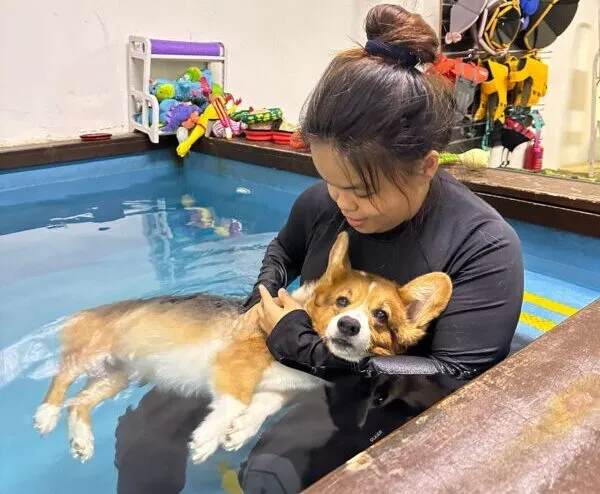
 Canine hydrotherapy, also known as water therapy or aquatic therapy, is a form of physical therapy that harnesses the properties of water to help treat musculoskeletal and neurological conditions in dogs. From reducing arthritis discomfort to enhancing function after an injury or surgery, hydrotherapy offers a wide range of benefits for our furry friends.
There are three main types of hydrotherapy for dogs: underwater treadmill, whirlpool therapy, and hydrotherapy pools, each designed to provide the best possible care for your pup. The growing trend of hydrotherapy for pets stems from the healing properties of water, which can help alleviate pain, improve mobility, and offer a gentle yet effective form of exercise.
However, it’s crucial to ensure that hydrotherapy sessions are conducted by a certified hydrotherapist or under the guidance of your veterinarian, who can prescribe the appropriate exercises for your dog’s specific needs.
Canine hydrotherapy, also known as water therapy or aquatic therapy, is a form of physical therapy that harnesses the properties of water to help treat musculoskeletal and neurological conditions in dogs. From reducing arthritis discomfort to enhancing function after an injury or surgery, hydrotherapy offers a wide range of benefits for our furry friends.
There are three main types of hydrotherapy for dogs: underwater treadmill, whirlpool therapy, and hydrotherapy pools, each designed to provide the best possible care for your pup. The growing trend of hydrotherapy for pets stems from the healing properties of water, which can help alleviate pain, improve mobility, and offer a gentle yet effective form of exercise.
However, it’s crucial to ensure that hydrotherapy sessions are conducted by a certified hydrotherapist or under the guidance of your veterinarian, who can prescribe the appropriate exercises for your dog’s specific needs.
 While professional hydrotherapy facilities offer specialized equipment and expertise, there are several at-home hydrotherapy options for dogs that can also provide significant benefits. These options include swimming pools, natural bodies of water, DIY underwater treadmills, and home whirlpool therapy.
Each of these methods can be tailored to your dog’s specific needs and health conditions, ensuring a comfortable and beneficial experience for your furry friend.
While professional hydrotherapy facilities offer specialized equipment and expertise, there are several at-home hydrotherapy options for dogs that can also provide significant benefits. These options include swimming pools, natural bodies of water, DIY underwater treadmills, and home whirlpool therapy.
Each of these methods can be tailored to your dog’s specific needs and health conditions, ensuring a comfortable and beneficial experience for your furry friend.
 To ensure the safety and effectiveness of at-home hydrotherapy for your dog, several precautions should be taken. These include consulting with a veterinarian, providing supervision and assistance during hydrotherapy sessions, and using proper equipment and flotation devices.
By following these guidelines, you can help create a positive and beneficial hydrotherapy experience for your dog while minimizing potential risks and complications.
To ensure the safety and effectiveness of at-home hydrotherapy for your dog, several precautions should be taken. These include consulting with a veterinarian, providing supervision and assistance during hydrotherapy sessions, and using proper equipment and flotation devices.
By following these guidelines, you can help create a positive and beneficial hydrotherapy experience for your dog while minimizing potential risks and complications.
 To get the most out of at-home hydrotherapy for your dog, consider the following tips: create a comfortable environment, establish a routine, monitor progress and adjust sessions as needed.
By implementing these strategies, you can enhance the effectiveness of hydrotherapy and support your dog’s overall health and well-being.
To get the most out of at-home hydrotherapy for your dog, consider the following tips: create a comfortable environment, establish a routine, monitor progress and adjust sessions as needed.
By implementing these strategies, you can enhance the effectiveness of hydrotherapy and support your dog’s overall health and well-being.
 While at-home hydrotherapy can offer numerous benefits for your dog, there are situations when seeking professional help is necessary. These include complex medical conditions, limited progress or regression, and equipment and facility limitations.
By recognizing when professional assistance is needed, you can ensure that your dog receives the best possible care and support for their health and well-being.
While at-home hydrotherapy can offer numerous benefits for your dog, there are situations when seeking professional help is necessary. These include complex medical conditions, limited progress or regression, and equipment and facility limitations.
By recognizing when professional assistance is needed, you can ensure that your dog receives the best possible care and support for their health and well-being.